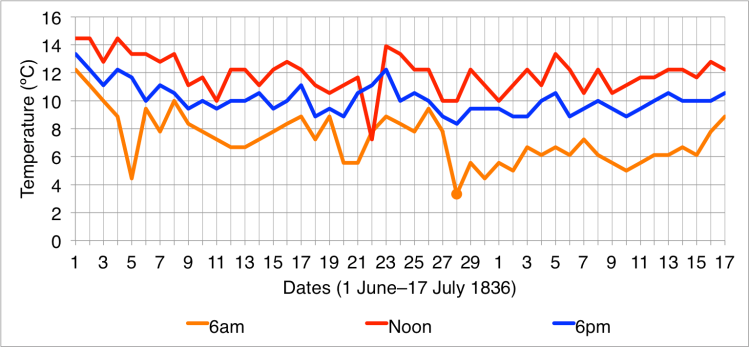My PhD was on the past climate of southeastern Australia. This involved looking at lots of different sources of old weather data from the 1800s. Newspapers, government records and farmer’s diaries: each source an important clue to the history of Australia’s climate.
While my work focussed mainly on quantitative data (numbers) rather than qualitative descriptions of what happened (words), using both sources of information can improve our understanding of the weather of the past. Plus, much like music and lyrics (great film), they tell a much better story together.
I want to share some of the more exciting events in the archives of Australia’s weather. Everyone loves talking about the weather, and extreme events, woah! Can we talk about anything else? So let’s start with an easy one. A classic. Sunday 28 June, 1836: snowfall in old Sydney town.
The data
The meteorological table published in The Sydney Herald reported snow on the morning of the 28th, with a 6am temperature of 38ºF (3.3ºC). The Herald published weather tables from 1831 until 1838 and this was the only time that the word ‘Snow’ appeared in the description. Temperature data were also published in The Sydney Monitor in the 1830s, put unfortunately no weather tables were published during the snowfall.

Sydney newspapers claimed that it was the first time snow had fallen in Sydney since European settlement in 1788:
For the first time in the memory of the oldest inhabitants, snow fell in Sydney on the morning of Tuesday last. About seven o’clock in the morning a drifting fall covered the streets, nearly an inch in depth; and it really was amusing to witness how the “natives” stared at so unexpected a visitor…Some of the “old hands” expressed a hope that their old acquaintances Messrs. Frost and Snow do not intend emigrating to New South Wales (“Domestic Intelligence–A stranger”, Sydney Herald, 30 June 1836, page 2).
This event piques the interest of historians and weather buffs alike, and I’m not the only one to have written on this white winter day in Australia’s colonial capital (see more info here and here). While some doubt its authenticity, the temperature observations and newspaper accounts suggest that the residents of Sydney really did wake on Tuesday 28 June to a blanket of snow covering the streets.
The temperature data for the month of June and the first half of July, from the Herald, looks like this:

You can see the clear dip in temperature on the morning of the 28th to just above 3ºC. Snow needs ground temperatures to be generally less than 5ºC, and the coldest part of the day is normally just before dawn, so conditions would have been good for a dusting, if not the snowball fight conditions that were reported.
Snow also apparently fell on 3 July 1836, but “in less abundance” than the fall of 28 June (“Domestic– Snow”, The Australian, 5 July 1836, page 2). The continuing cold temperatures recorded at 6am for most of early July seem to attest to this.
But how reliable are these old weather records?
There aren’t many details about how or where the Herald obtained their temperature data. There are problems associated with historical temperature observations that were not taken using today’s methods – that is another post for another time. The instrumental data are therefore not likely to be very accurate. However, the agreement between the meteorological data and newspaper reports suggest that it was very cold and it seems to me that snow really did fall on that day in June, rather than a lot of hail.
Temperature data from Sydney for the rest of 1836 suggests that in fact the whole year was cold, and pretty wet too. Studies looking at snowfall in southern Africa and natural records of temperature such as tree rings show that indeed the whole Southern Hemisphere was affected by these chilly conditions (linked articles behind paywalls sorry, will update when I find free options). The snowfall in Sydney could have been a symptom of something much bigger.
The historical climatologists who looked at the cold winters in southern Africa have suggested that ash associated with a tropical volcanic eruption in 1835 may have blocked the sunlight and caused a drop in temperatures in the late 1830s. Research is still underway to take a closer look at this strange period, so stay tuned!